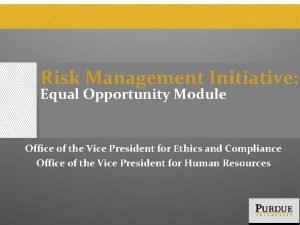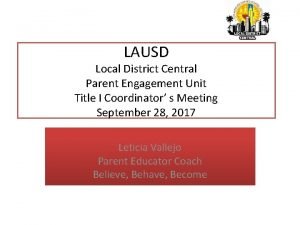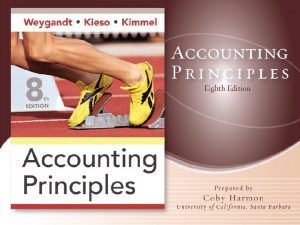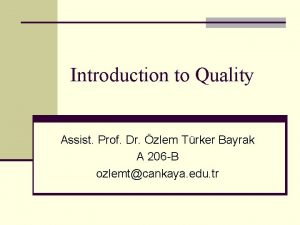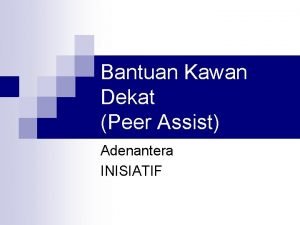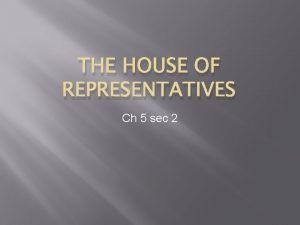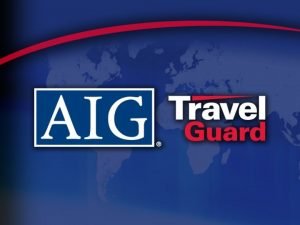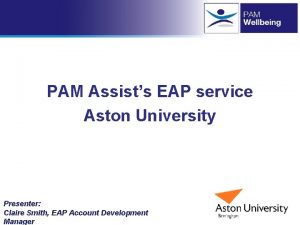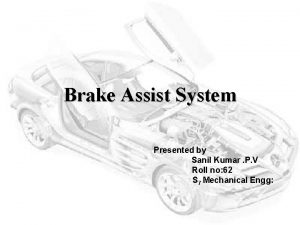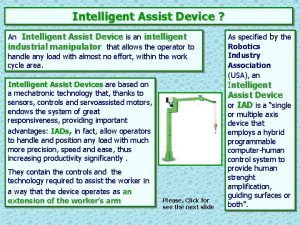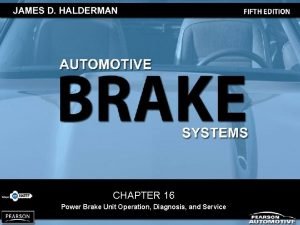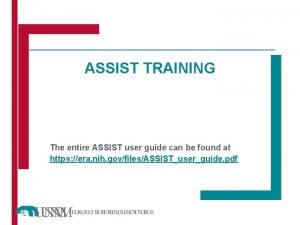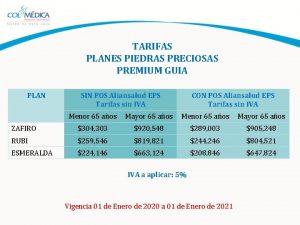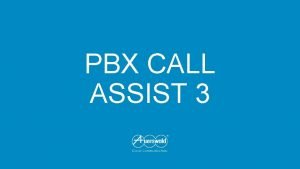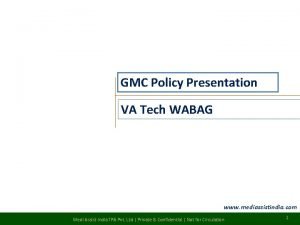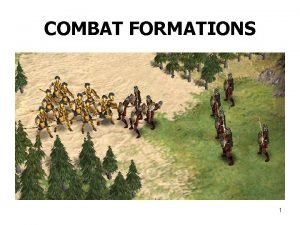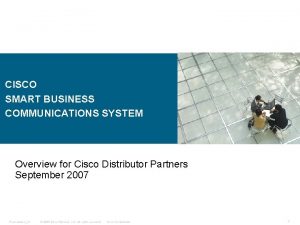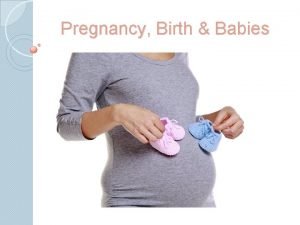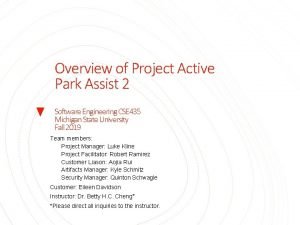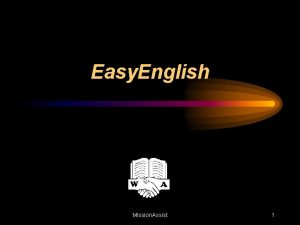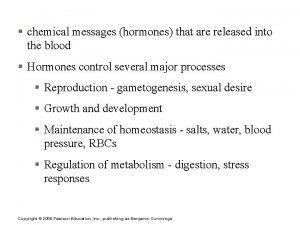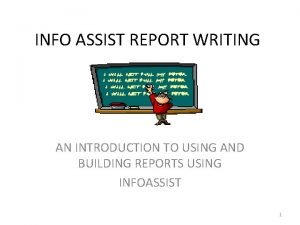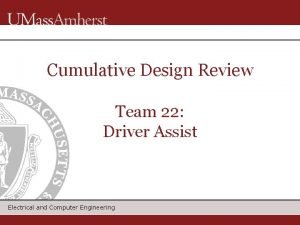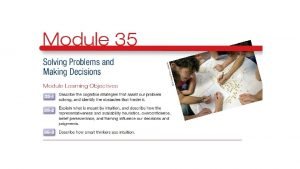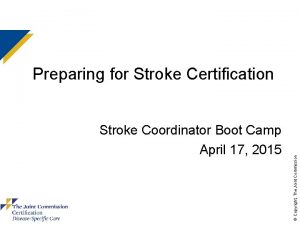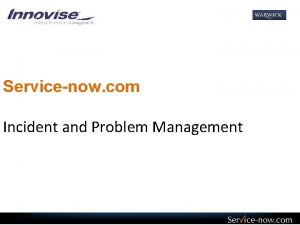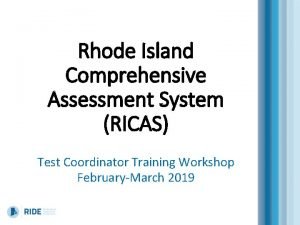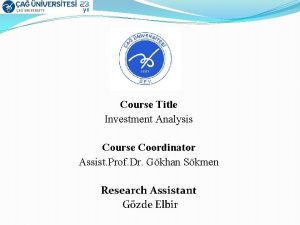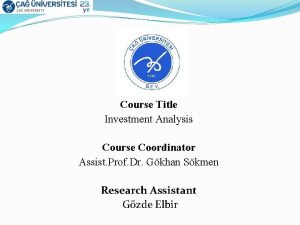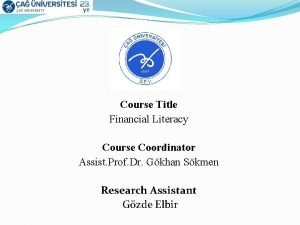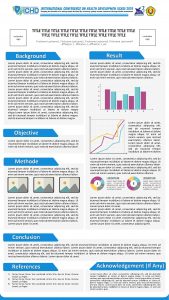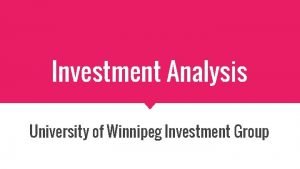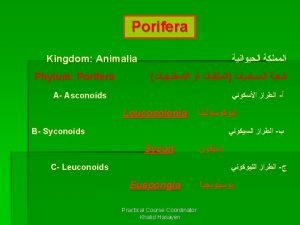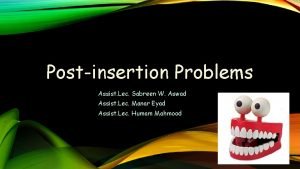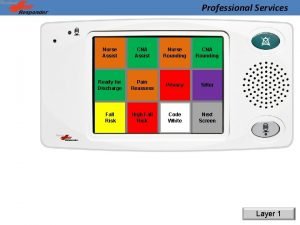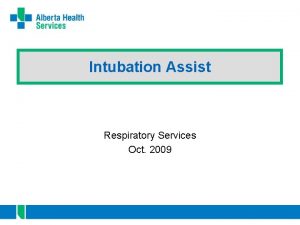Course Title Investment Analysis Course Coordinator Assist Prof










































- Slides: 42

Course Title Investment Analysis Course Coordinator Assist. Prof. Dr. Gökhan Sökmen Research Assistant Gözde Elbir

Learning Objectives After studying this chapter; �You will be able to know how to determine a firm’s cost of equity capital � You will be able to understand the impact of beta in determining the firm’s cost of equity capital � You will be able to know how to determine the firm’s overall cost of capital � You will be able to understand the impact of flotation costs on capital budgeting

The Cost of Capital �Whenever a firm has extra cash, it can take one of two actions: 1. It can pay out the cash directly to its investors or 2. It can invest the extra cash in a project, paying out the future cash flows of the project. �Which action would the investors prefer? If investors can reinvest the cash in a financial asset (a stock or bond) with the same risk as that of the project, the investors would desire the alternative with the higher expected return. The idea is illustrated in the Figure:

The Cost of Capital

What is the difference equity financing and debt financing? DEBT FINANCING EQUITY FINANCING ADVANTAGES Keep full ownership Less risk than debt No obligations after paying debt No paying back funds Interest is tax deductible Gain credibility through investor networks Short and long term options Investors don’t expect immediate return on investment More cash on hand Fixed payments for better budgeting DISADVANTAGES Must pay back Investor returns could be more than debt payments Could cause cash flow issues Investor gets some ownership Usually need collateral Must consult investor for decisions

Cost of Debt �

Example 1 The existing yield on the debt was 9, 40 percent. We shall assume new debt can be issued at the same going market rate and that the firm is paying a 25 percent tax. What is the cost of debt?

Example 2 The existing yield on the debt was 10. 84% and tax rate is 40%. What is the cost of debt? Yield = 10. 84%; Tax rate = 40% Kd (Cost of debt) = Y(1 – T) Kd (Cost of debt) = 10. 84% (1 – 0. 40) = 10. 84% × 0. 65 = 6. 5%

Cost of Equity Capital Firm with excess cash Pay cash dividend Shareholder invests in financial asset A firm with excess cash can either pay a dividend or make a capital investment Invest in project Shareholder’s Terminal Value � Because stockholders can reinvest the dividend in risky financial assets, the expected return on a capital-budgeting project should be at least as great as the expected return on a financial asset of comparable risk.

Cost of Preferred Stock �Constant annual payment with no maturity date for principal payment �Divide annual dividend by current price �Represents rate of return to preferred stockholders and annual cost to corporation for preferred stock issue �Proceeds to firm are equal to selling price in market minus flotation cost

Cost of Preferred Stock �The cost of preferred stock is as follows Kp (Cost of preferred stock) = Dp / (Pp – F) Kp = Cost of preferred stock Dp = Annual dividend on preferred stock Pp = Price of preferred stock F = Flotation, or selling cost

Example 3 Assume annual dividend $10. 50; preferred stock $100; flotation or selling cost $4 Kp = Dp / (Pp – F) = $10. 50 / ($100 – 4) = $10. 50 / $96 = $10. 94%

Cost of Common Equity • To determine cost of common stock, the firm must be sensitive to pricing and performance demands of current and future stockholders • Dividend valuation model: P 0 = D 1 / (Ke – g) P 0 = Price of the stock today D 1 = Dividend at the end of the year (or period) Ke = Required rate of return g = Constant growth rate in dividends

Example 4 Assume that: D 1 = $2, P 0 = $40, and g = 7%, Ke = ? Ke = (D 1 / P 0) + g = ($2 / $40) + 7% = 5% +7% = 12%

Example 5 Your company is expected to pay a dividend of $4. 40 per share next year (D 1). Dividends have grown at a steady rate of 5. 1% per year and the market expects that to continue (g). The current stock price is $50 (P 0). What is the cost of equity? Ke = (D 1 / P 0) + g Ke = (4. 40 / 50) + 0. 051 = 0. 139

Example 6 �Suppose TB Pirates, Inc. is expected to pay a $2 dividend in one year. If the dividend is expected to grow at 5% per year and the required return is 20%, what is the price? D 1 = $2. 00 g = 5% Ke = 20%

Cost of Common Equity �One whose dividends are expected to grow forever at a constant rate, g. D 1 = D 0(1+g)1 D 2 = D 0(1+g)2 Dt = Dt(1+g)t �D 0 = Dividend JUST PAID �D 1 – Dt = Expected dividends

Example 7 �D 0 = $2. 00 and constant g = 6% �D 3 = ? D 1 = D 0(1+g) = 2(1. 06) = $2. 12 D 2 = D 1(1+g) = 2. 12(1. 06) = $2. 2472 D 3 = D 2(1+g) = 2. 2472(1. 06) = $2. 3820

Gordon Growth Model D 0(1+g) P 0 = Ke - g D 1 = Ke - g

Example 8 �Suppose Big D, Inc. just paid a dividend of $0. 50. It is expected to increase its dividend by 2% per year. If the market requires a return of 15% on assets of this risk, how much should the stock be selling for? D 0= $0. 50 g = 2% Ke = 15%

Required Return on Common Stock Using the Capital Asset Pricing Model • Capital Asset Pricing Model (CAPM) Ri = Rf + βi (Rm − Rf) Ri = Required return on common stock Rf = Risk-free rate of return, usually the current rate on Treasury bill securities βi = Beta coefficient (measures the historical volatility of an individual stock’s return relative to a stock market index) Rm = Return expected in the market as measured by an approximate index Market risk premium = Rm − Rf

Estimation of BETA � Market Portfolio – Portfolio of all assets in the economy. In practice, a broad stock market index, such as the S&P 500, is used to represent the market. � Beta – Sensitivity of a stock’s return to the return on the market portfolio. 1. Betas may vary over time. 2. The sample size may be inadequate. 3. Betas are influenced by changing financial leverage and business risk.

Stability of BETA �Most analysts argue that betas are generally stable for firms remaining in the same industry. �That is not to say that a firm’s beta cannot change. �Changes in product line �Changes in technology �Deregulation �Changes in financial leverage

Using an Industry BETA �It is frequently argued that one can better estimate a firm’s beta by involving the whole industry. �If you believe that the operations of the firm are similar to the operations of the rest of the industry, you should use the industry beta. �If you believe that the operations of the firm are fundamentally different from the operations of the rest of the industry, you should use the firm’s beta. �Do not forget about adjustments for financial leverage.

Example 9 • Assume that: Rf = 5. 5%, Rm = 12%, and βi = 1. 0 Ri would be: Ri = 5. 5% + 1. 0 (12% – 5. 5%) = 5. 5% + 1. 0 (6. 5%) Ri = 5. 5% + 6. 5% = 12%

Example 10 Suppose the stock of Stansfield Enterprises, a publisher of online presentations, has a beta of 1. 5. The firm is 100% equity financed. Assume a risk-free rate of 3% and a market risk premium of 7%. What is the appropriate discount rate for an expansion of this firm? Ri = Rf + βi (Rm − Rf) Ri = 3% + (1. 5 × 7%) Ri = 13. 5%

Example 11 Company’s equity beta = 1. 2 Current risk-free rate = 7% Expected market risk premium = 6% What is the cost of equity capital? Ri = Rf + βi (Rm − Rf) Ri = 0. 07+1. 2 (0. 06) = 14. 2 %

Bond yield + risk premium �The bond yield plus risk premium approach is another method we can use to determine the value of an asset, specifically, a company’s publicly traded equity. �The method allows us to estimate the required return on an equity by adding the equity’s risk premium to the yield to maturity on company’s long-term debt. �Cost of equity = Bond yield + Risk premium � We can only utilize the approach if the entity has publicly traded debt, and it does not produce as accurate an estimate as the capital asset pricing model or discounted cash flow analysis.

Cost of Retained Earnings • Sources of capital for common stock equity • Purchaser of new shares—external source • Retained earnings—internal source • Represent and past earnings of firm minus previously distributed dividends • Belong to current stockholders—paid as dividends or reinvested in firm • Reinvestments represent source of equity capital supplied by current stockholders • Opportunity cost involved

Cost of Retained Earnings • The cost of retained earnings is equivalent to the rate of return on the firm’s common cost, representing the opportunity cost • Ke represents both the required rate of return on common stock and the cost of equity in the form of retained earnings Ke = (D 1 / P 0) + g � Ke = Cost of common equity in the form of retained earnings � D 1 = Dividend at the end of the first year, $2 � P 0 = Price of stock today, $40 � g = Constant growth rate in dividends, 7% Ke = (D 1 / P 0) + g = ($2 / $40) + 7% = 5% + 7% = 12%

Cost of New Common Stock • Slightly higher return than Ke expected • Represents required rate of return of present stockholders • Needed to cover distribution costs of new securities Common Stock Ke = (D 1 / P 0) + g New common stock Kn = [D 1 / (P 0 – F)] + g

Optimum Capital Structure—Weighting Costs �Desire to achieve minimum overall cost of capital �Calculated decisions required on appropriate weights for � Debt � Preferred stock � Common stock financing �Capital mix determined by � Considering present capital structure � Ascertaining if current position optimal

Optimum Capital Structure—Weighting Costs • Assessment of different plans: • Firm able to initially reduce weighted average cost of capital with debt financing • Beyond Plan B, continued use of debt becomes unattractive and greatly increases costs of sources of financing

Example 12 Assume the capital structure for the company: Debt 35% Preferred stock 15% Common equity 50% The following facts are also provided: Bond yield to maturity 9% Corporate tax rate 25% Dividend, preferred stock $ 8. 50 Price, preferred stock $ 100. 00 Flotation cost, preferred stock $ 2. 00 Dividend, common stock $ 1. 20 Price, common stock $ 30. 00 Growth rate, common stock 9% Compute the weighted average cost of capital.

Example 13 �

Example 14 �

Example 15 Now combine these with the weights in the capital structure to compute the weighted average cost of capital. Cost Weights Weighted cost Debt Kd 6. 75% 35% 2. 36% Preferred stock Kp 8. 67% 15% 1. 30% Common equity (retained earnings) Ke 13% 50% 6. 50% Weighted average cost of capital 10. 16%

Cost of Capital Curve

Cost of Capital in the Capital Budgeting Decision • Current cost of capital for each source of funds important for capital budgeting decision • Required rate of return, or discount rate, will be weighted average cost of capital • Common stock value of firm will stay same or increase as long as firm earns cost of capital • Stockholders’ expectations being met

The Marginal Cost of Capital • Market may demand higher cost of capital for each amount of funds if large amount of financing required • Equity (ownership) capital represented by retained earnings • Retained earnings cannot grow indefinitely, as firm’s capital must expand • Retained earnings limited to past and present earnings that can be redeployed into investments

The Marginal Cost of Capital • Assumptions: • Firm has $23. 40 million of retained earnings available for investment • Since retained earnings are 60 percent of the capital structure, there adequate retained earnings to support up to $39 million • Adequate retained earnings to support capital structure X = Retained earnings / Percent of retained earnings in the capital structure • Where X represents size of capital structure that retained earnings will support X = $23. 40 million / 0. 60 = $39 million

Cost of Components in the Capital Structure
 West lafayette campus title ix coordinator
West lafayette campus title ix coordinator Lausd central district
Lausd central district Course title and course number
Course title and course number Investment analysis and portfolio management course
Investment analysis and portfolio management course Fixed investment and inventory investment
Fixed investment and inventory investment Account title for investment
Account title for investment Redcap choa
Redcap choa Mcdp-1 defines trust as a product of which of the following
Mcdp-1 defines trust as a product of which of the following Quality assist
Quality assist Second heart assist
Second heart assist Cisco smart assist
Cisco smart assist Peer assist
Peer assist Als assist
Als assist The whips assist the party leaders by
The whips assist the party leaders by Travel guard ez tips
Travel guard ez tips Pam assist
Pam assist Mechanical brake assist
Mechanical brake assist Intelligent assist device
Intelligent assist device One teach, one assist pros and cons
One teach, one assist pros and cons Unit 5 quiz 1 power assist systems
Unit 5 quiz 1 power assist systems Assist user guide
Assist user guide Atencion domiciliaria sanitas premium
Atencion domiciliaria sanitas premium Pbx call assist 2
Pbx call assist 2 School mental health assist
School mental health assist Mediassistindia login
Mediassistindia login Fire team formations
Fire team formations Business essentials smbs springchambers9to5mac
Business essentials smbs springchambers9to5mac Hengityspalje
Hengityspalje Gx assist side effects
Gx assist side effects Active park assist 2
Active park assist 2 Mission assist
Mission assist Thymosin and thymopoietin assist in the maturation of:
Thymosin and thymopoietin assist in the maturation of: Info assist
Info assist Assist electrical
Assist electrical What cognitive strategies assist our problem solving
What cognitive strategies assist our problem solving Title fly and title page
Title fly and title page Title title
Title title Duties and responsibilities of boy scout coordinator
Duties and responsibilities of boy scout coordinator Stroke coordinator boot camp
Stroke coordinator boot camp Servicenow problem coordinator role
Servicenow problem coordinator role Ricas math reference sheet
Ricas math reference sheet Psat coordinator manual
Psat coordinator manual Shep ghana
Shep ghana
